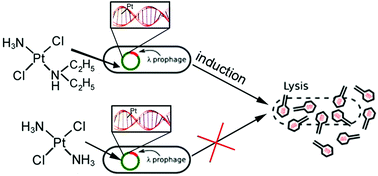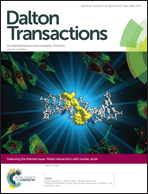The induction of lysis in lysogenic strains of Escherichia coli by a new antitumor transplatin derivative and its DNA interactions
Abstract
The toxicity of the new derivative of transplatin, namely trans-[PtCl2(DEA)(NH3)] (DEA = diethylamine), in which only one NH3 group was replaced by a small, non-bulky DEA ligand, in the cisplatin sensitive and resistant tumor cell lines was examined. The results indicate that this very small modification of the transplatin molecule results in a considerable enhancement of toxicity in the cancer cells. Thus, this finding is consistent with the thesis that the trans geometry in PtII-dichlorido compounds can also be effectively activated by the replacement of only one NH3 ligand in transplatin by the non-bulky ligand, such as the short aliphatic amine, (C2H5)2NH. We also demonstrate that trans-[PtCl2(DEA)(NH3)], in contrast to transplatin, can be grouped with the coordination compounds exhibiting antitumor activity and capable of inducing lysis in lysogenic bacteria. Thus, these results afford, for the first time, experimental support for the view that DNA is the potential cellular target also for antitumor derivatives of transplatin. DNA binding mode of trans-[PtCl2(DEA)(NH3)] in cell-free media was examined as well. The results show that the small aliphatic DEA ligand has significant consequences for the DNA conformational changes. Unlike ‘classical’ transplatin, modification of DNA with trans-[PtCl2(DEA)(NH3)] leads to mainly bifunctional cross-links. The extent and destabilization of the double-helical structure of DNA by this new trans-platinum complex are similar to those induced by cisplatin. As a consequence the lesions effectively inhibit transcription of template DNA similarly to the lesions of cisplatin, but markedly more than the lesions of transplatin. The stronger inhibition of DNA transcription by the adducts of trans-[PtCl2(DEA)(NH3)] in comparison with the adducts of transplatin adds a new dimension to the impact of the activated trans geometry in platinum compounds on biological processes, possibly including DNA transcription.

- This article is part of the themed collection: Metal Interactions with Nucleic Acids

 Please wait while we load your content...
Please wait while we load your content...